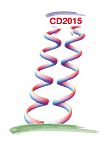Speaker
Henryk witala
(Jagiellonian University, Krakow)
Description
Comparison of theoretical predictions based on a nucleon-nucleon potential with data for elastic nucleon-deuteron (Nd) scattering and nucleon induced deuteron breakup reveals the importance of the three-nucleon force (3NF). Inclusion of semi-phenomenological 3NF models into calculations in many cases improves the data description. However, some serious discrepancies remain even when 3NF is included. At low energies the prominent examples were found for the vector analyzing power in elastic Nd scattering and for the neutron-deuteron (nd) breakup cross sections in neutron-neutron (nn) quasi-free-scattering (QFS) and symmetric-space-star (SST) geometries [1]. Since both these configurations depend predominantly on the S-wave nucleon-nucleon (NN) force components, these cross section discrepancies have serious consequences for the nn 1S0 force component. At energies above ≈ 100 MeV current 3NF’s only partially improve the description of data for cross section and spin observables in elastic Nd scattering and breakup. The complex angular and energy behavior of analyzing powers, spin correlation and spin transfer coefficients fails to be explained by standard nucleon-nucleon interactions alone or combined with current models of 3NF’s [2-3]. One of the reasons for the above disagreements could be a lack of consistency between 2N and 3N phenomenological potentials used or/and omission of important terms in the applied 3NF. The Chiral Effective Field Theory approach provides consistent two- and three-nucleon forces. The 3NF occurs for the first time at next-to-next-to leading order (N2LO) of chiral expansion. The chiral NN potentials have been constructed up to N4LO order of chiral expansion [4]. The N3LO and N4LO NN forces when used in 3N calculations provide description of NN data of the same quality as standard, realistic NN potentials. The chiral 3NF at N3LO, derived recently, consists of long range parts with the 2π-exchange, 1π-2π and ring terms [5] and a short-range contributions 2π-contact and relativistic corrections of order 1/m [6]. This is supplemented by 1π- and 3N- contact terms. Preliminary results obtained with chiral forces for elastic Nd scattering and breakup will be presented.
References
1. H. Witala et al., Phys. Rev. C 83, 034004 (2011).
2. Y. Maeda et al., Phys. Rev. C 76, 014004 (2007).
3. K. Sekiguchi et al., Phys. Rev. C 79, 054008 (2009).
4. E. Epelbaum et al., arXiv:14.12.4623.
5. V. Bernard et al., Phys. Rev. C 77, 064004 (2008).
6. V. Bernard et al., Phys. Rev. C 84, 054001 (2011).
Primary author
Henryk witala
(Jagiellonian University, Krakow)

